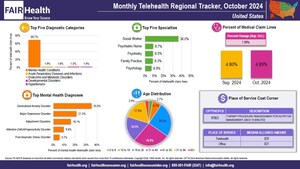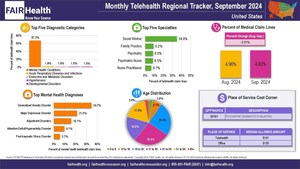Change in Telehealth Utilization Varied by Region in United States from June to July 2022
Greatest Changes Were a 5.7 Percent Increase in West, and 3.3 Percent Decrease in Northeast, according to FAIR Health's Monthly Telehealth Regional Tracker
Telehealth Utilization in Nation as a Whole Relatively Stable
NEW YORK, Oct. 3, 2022 /PRNewswire/ -- Telehealth utilization, as measured by telehealth's share of all medical claim lines, varied by US region from June to July 2022, according to FAIR Health's Monthly Telehealth Regional Tracker.1 Telehealth utilization rose in three of the four US census regions—Midwest, South and West—with the greatest increase (5.7 percent) in the West, where telehealth utilization rose from 7.0 to 7.4 percent of medical claim lines; the South increased 4.9 percent and the Midwest 2.5 percent. In the Northeast, telehealth utilization fell 3.3 percent, from 6.0 percent of medical claim lines to 5.8 percent. Overall, national telehealth utilization increased 1.9 percent from June to July, after declining 3.7 percent from May to June, rising from 5.2 percent of medical claim lines in June to 5.3 percent in July. The data represent the privately insured population, including Medicare Advantage and excluding Medicare Fee-for-Service and Medicaid.
Specialties
In July 2022, social worker remained the top-ranking telehealth specialty in all regions and nationally, as it had since February 2022. But in the South, social worker fell by 8.7 percent of telehealth claim lines in July 2022, with psychiatrist increasing by 8.1 percent, although that specialty remained in third place.
Additionally in July 2022, primary care nonphysician and psychologist changed positions in the Midwest, with the former ending in third place and the latter in fourth place. In the Northeast, psychiatrist and psychologist changed positions, with the former ending in third place and the latter in fourth place.
Diagnoses
Nationally and in every region in July 2022, COVID-19 ranked second among telehealth diagnoses. This was the rank it also held in June 2022 everywhere but in the South, where COVID-19 ranked third in June.
Also in July 2022, acute respiratory diseases and infections fell out of the top five telehealth diagnoses in the Northeast, with joint/soft tissue diseases and issues joining the list instead. In addition, acute respiratory diseases and infections fell out of the top five telehealth diagnoses in the West and was supplanted by endocrine and metabolic disorders.
Procedure Codes
In July 2022, the rankings of the top five telehealth procedure codes did not change nationally or in any region when compared to the prior five months. The number one telehealth procedure code nationally and in every region remained CPT®2 90837, one-hour psychotherapy.
Costs
For July 2022, the Telehealth Cost Corner spotlighted the cost of CPT 96127, assessment of emotional or behavioral problems. Nationally, the median charge amount for this service when rendered via telehealth was $17.72, and the median allowed amount was $8.34.3
About the Monthly Telehealth Regional Tracker
Launched in May 2020 as a free service, the Monthly Telehealth Regional Tracker uses FAIR Health data to track how telehealth is evolving from month to month. An interactive map of the four US census regions allows the user to view an infographic on telehealth in a specific month in the nation as a whole or in individual regions. Each infographic shows month-to-month changes in telehealth's percentage of medical claim lines, as well as that month's top five telehealth procedure codes, diagnoses and specialties. Additionally, in the Telehealth Cost Corner, a specific telehealth procedure code is featured, with its median charge amount and median allowed amount.
FAIR Health President Robin Gelburd stated: "We welcome sharing these varying windows into telehealth utilization as it continues to evolve. This is one of the many ways we pursue our healthcare transparency mission."
For the Monthly Telehealth Regional Tracker, click here.
Follow us on Twitter @FAIRHealth
About FAIR Health
FAIR Health is a national, independent nonprofit organization that qualifies as a public charity under section 501(c)(3) of the federal tax code. It is dedicated to bringing transparency to healthcare costs and health insurance information through data products, consumer resources and health systems research support. FAIR Health possesses the nation's largest collection of private healthcare claims data, which includes over 38 billion claim records and is growing at a rate of over 2 billion claim records a year. FAIR Health licenses its privately billed data and data products—including benchmark modules, data visualizations, custom analytics and market indices—to commercial insurers and self-insurers, employers, providers, hospitals and healthcare systems, government agencies, researchers and others. Certified by the Centers for Medicare & Medicaid Services (CMS) as a national Qualified Entity, FAIR Health also receives data representing the experience of all individuals enrolled in traditional Medicare Parts A, B and D; FAIR Health includes among the private claims data in its database, data on Medicare Advantage enrollees. FAIR Health can produce insightful analytic reports and data products based on combined Medicare and commercial claims data for government, providers, payors and other authorized users. FAIR Health's systems for processing and storing protected health information have earned HITRUST CSF certification and achieved AICPA SOC 2 compliance by meeting the rigorous data security requirements of these standards. As a testament to the reliability and objectivity of FAIR Health data, the data have been incorporated in statutes and regulations around the country and designated as the official, neutral data source for a variety of state health programs, including workers' compensation and personal injury protection (PIP) programs. FAIR Health data serve as an official reference point in support of certain state balance billing laws that protect consumers against bills for surprise out-of-network and emergency services. FAIR Health also uses its database to power a free consumer website available in English and Spanish, which enables consumers to estimate and plan for their healthcare expenditures and offers a rich educational platform on health insurance. An English/Spanish mobile app offers the same educational platform in a concise format and links to the cost estimation tools. The website has been honored by the White House Summit on Smart Disclosure, the Agency for Healthcare Research and Quality (AHRQ), URAC, the eHealthcare Leadership Awards, appPicker, Employee Benefit News and Kiplinger's Personal Finance. FAIR Health also is named a top resource for patients in Dr. Marty Makary's book The Price We Pay: What Broke American Health Care—and How to Fix It and Dr. Elisabeth Rosenthal's book An American Sickness: How Healthcare Became Big Business and How You Can Take It Back. For more information on FAIR Health, visit fairhealth.org.
Contact:
Rachel Kent
Senior Director of Marketing
FAIR Health
646-396-0795
[email protected]
1 A claim line is an individual service or procedure listed on an insurance claim.
2 CPT © 2021 American Medical Association (AMA). All rights reserved.
3 A charge amount is the provider's undiscounted fee, which a patient may have to pay when the patient is uninsured, or when the patient chooses to go to a provider who does not belong to the patient's plan's network. An allowed amount is the total fee paid to the provider under an insurance plan. It includes the amount that the health plan pays and the part the patient pays under the plan's in-network cost-sharing provisions (e.g., copay or coinsurance if the patient has met the deductible).
SOURCE FAIR Health

WANT YOUR COMPANY'S NEWS FEATURED ON PRNEWSWIRE.COM?
Newsrooms &
Influencers
Digital Media
Outlets
Journalists
Opted In






Share this article